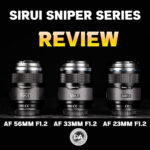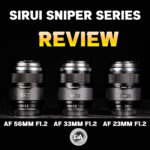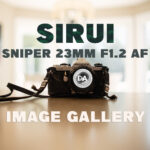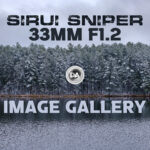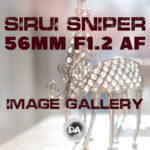
Sirui Sniper 75mm F1.2 X-Mount Review
Sirui launched their “Sniper” series of autofocus lenses in late 2023. I’ve done an overview of the series here. The Sniper Series was initially made up of 3 APS-C specific lenses – a 23mm F1.2, 33mm F1.2, and 56mm F1.2 lens, but they have now expanded the series to include both a wider angle option (Sniper 16mm F1.2) and a longer telephoto option (Sniper 75mm F1.2). It is these latter two that I am currently reviewing, and today’s review focuses on the telephoto option – the Sirui Sniper 75mm F1.2 AF lens. These can be purchased individually for $349 USD each (though various discounts will provide a little fluctuation in pricing). These lenses will be available in Fuji X-mount (reviewed here), Sony E-mount, and Nikon Z mount configurations, though in all mounts they are designed to cover the APS-C and not the full frame image circle. Find out by watching my video review below…or just reading on.
Follow Me @ YouTube | Patreon | Instagram | Facebook | DA Merchandise | Flickr | 500px
Thanks to Sirui for sending me a set of review samples of the lenses. As always, this is a completely independent review. All opinions and conclusions are my own. I’m doing this review on a 40MP Fujifilm X-H2 camera.
__________________________________________________________________________________________________
Here’s a quick way to access my reviews of each lens in the series:
I’m doing this review on Fuji X-mount since that is what Sirui had available to send me. In many ways this is jumping right into the fire, as there is no platform more optically demanding than the 40MP sensor on my Fujifilm X-H2. This is the equivalent of over 90MP on full frame, a resolution point that is currently 30+MP higher than what is even available on full frame. That creates an extremely demanding optical test that will push this new series to the limits. Is this 75mm F1.2 Sniper lens up to the challenge? As with the other lenses, that answer really depends on your priorities and expectations as a photographer, though I will say that I think that the Sniper 75mm is the best of the bunch optically. It does face very stiff competition from the excellent Viltrox Pro AF 75mm F1.2 (my review here), though the Viltrox is bigger, heavier, and more expensive.

For that size, however, you get more features (aperture ring, AF/MF switch), weather sealing, and it is definitely sharper. But this new Sniper 75mm is no slouch optically, and while it isn’t as transcendently sharp as the Viltrox at F1.2, it helps compensate by both a very useful amount of sharpness along with gorgeous bokeh.

This is definitely the “bokeh monster” of the Sniper series, capable of crushing backgrounds and delivering beautiful subject isolation.

75mm is the least traditional of the focal lengths in the Sniper series. Once you apply the 1.5x crop factor of the APS-C cameras that these lenses are designed for (whether Fuji, Sony, or Nikon), the 16, 23, 35, and 56mm become the full frame equivalents of 24, 35, 50, and 85mm – the most common prime focal lengths you could ask for. 75mm is a much less conventional 112.5mm full frame equivalent, and while that isn’t as flexible a focal length as some of these others, it a really great portrait focal length because you can shoot full length and still have the background blurred out. Viltrox’s Pro AF 75mm F1.2 has proven very popular for that reason.
All of these Sniper lenses have sported an F1.2 maximum aperture. That’s an obvious advantage for the F1.2 in two ways: 1) when shooting in low light conditions that large aperture can suck in more light 2) the depth of field will shallower at F1.2 than F1.4, allowing for larger, softer bokeh highlights and a more blurred out background. The fact that the Sirui Nightwalker 75mm T1.2 exists (my video review here) tells me that the light transmission for the lens is excellent, as the T-stop actually matches the F-stop (fairly rare, in my experience). This is a very bright lens, and that’s going to be useful in a lot of situations. It has no problem when the light gets dim.

The Sniper series has come in three different finish option: a black/grey finish with carbon fiber accents (the lenses I’m testing come in this finish), a white finish, and a silver finish. Each is available for the three different mounts that lens is sold for. These photos cover the three older lenses as I’m reviewing the 16mm and 75mm lenses before public release.
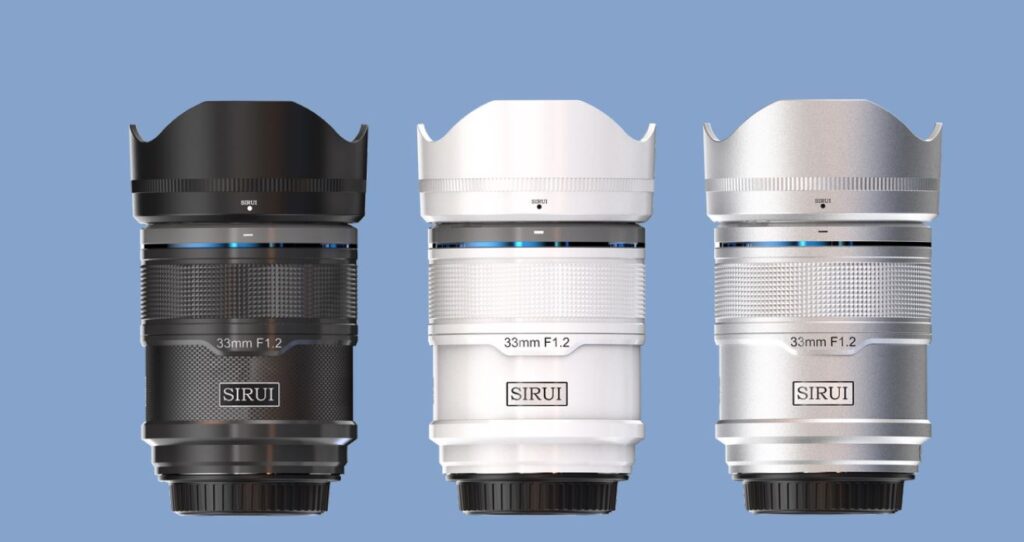
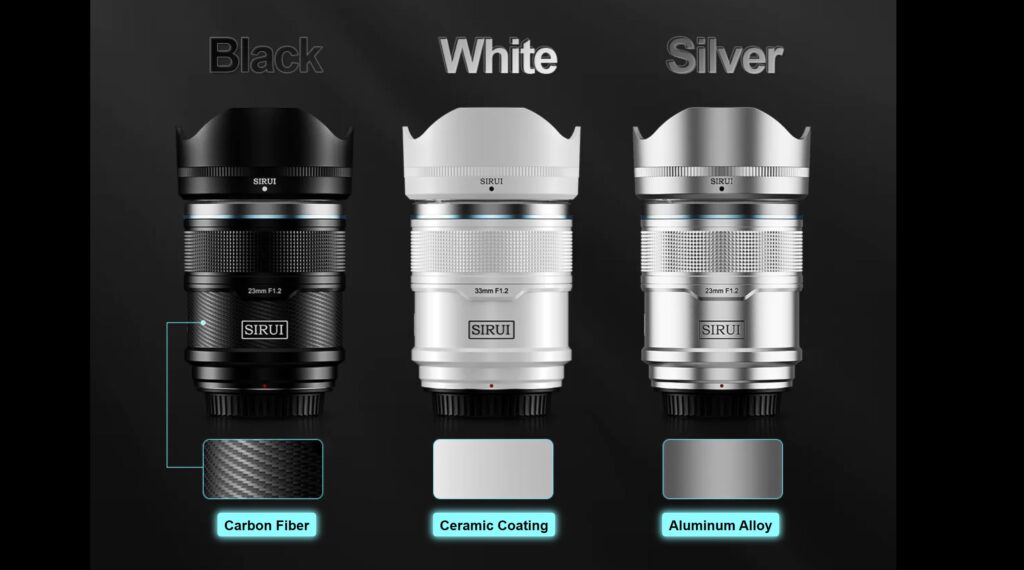

It is great to see Sirui forging their own design path, and I’ve been impressed across the three different lineups that I’ve tested (Sniper, Night Walker, and Saturn). So let’s take a closer look at this 75mm F1.2 lens from Sirui.
Sirui Sniper 75mm Build and Handling
The original Sniper lenses all shared a common outer shell and exterior dimensions though with a slight weight variation due to the larger optical elements in some. There’s a little more variation in the new 16mm and 75mm F1.2 designs, however, as would be expected with these slightly more extreme focal lengths. This Sniper 16mm is the lightest of the series (smallest glass elements), weighing in at 375g (13.2 oz) on my scale. The 16mm and 75mm Sniper lenses share a common length (94mm or 3.7″), but you can see that the 75mm is considerably wider than the 16mm.

I measure the 75mm at nearly 75mm (2.95″), with the 16mm being a slimmer 70mm (2.75″). The 75mm is the heaviest of the group at 466g (16.1 oz), which is unsurprising as it has easily the most glass inside. The 16mm, 23mm, 33mm, and 56mm Sniper lenses all share a common 58mm front filter thread, but the filter threads on the 75mm grow to 67mm to accommodate the wider diameter of the lens.

The weight will very slightly vary according to lens and mount. The X-mount that I’m testing is actually the lightest (by a few grams), due to the X-mount being the smallest of the three in diameter. Nikon’s Z-mount is the largest in diameter, with Sony E-mount in between.

So how does the 75 x 94mm and 466g of the Sniper 75mm F1.2 compares to the Viltrox Pro AF 75mm F1.2? The Viltrox is 87 x 101 mm (3.4 x 4″) and weighs 670g (23.6oz). That makes the Sirui a whopping 200+ grams lighter, which is definitely significant. The Sniper 75mm is just 20g heavier than the Fujinon XF 56mm F1.2 WR (my review here) despite the significantly longer focal length of the Sirui. While the early Sniper lenses were heavier than some of their counterparts, this 75mm is sitting in a nice position when it comes to the size and weight of the lens.
The look of the Sniper lenses is unique. There’s not much here in terms of features, but the lenses do have an upscale look with a variety of textures and finishes. I’m reviewing the lenses labeled as being “black”, but black (at least in the typical lens sense) is not the vibe I get off these lenses. There are two metal sections (one near the lens mount and another in the middle of the lens) that has a traditional anodized satin black finish, but in between there is a section of genuine carbon fiber that looks very cool. Carbon fiber is a more upscale material and it definitely sets these lenses apart.

There are two badges in this section. One is a plate with the Sirui banding in raised metal lettering. The second is on the left side, and there is a another smaller badge that says AF and APS-C. Interestingly the word “Sniper” appears nowhere on the lens.

There are no switches on the lens barrel nor an aperture ring. That’s more noticeable here on Fuji, where aperture rings are fairly standard. Both of the F1.2 lenses that I’ve mentioned have both an aperture ring and weather sealing, so the Sirui is at a serious disadvantage in those areas, though, to be fair, it is between $200 and $600 cheaper than its main competitors.

The Sniper 75mm has a great profile to it on camera, with a nice, squat look that is a nice match to my larger X-H2 body.
The manual focus ring has a diamond pattern akin to Canon’s control rings rather than a typical ribbed finish. It’s one more area where the lenses maintain their own unique look.

The manual focus rings move smoothly and the weight is fairly light. Not so light that you can’t accurately focus, but a bit lighter than what I personally prefer. Sirui states that the focus throw is 360°, so plenty of room for precision.
After the focus ring is a blue accent ring that is nearly turquoise in color. Once again it is little different than other lens that I’ve tested, and it works. The final section at the front of the lens has a titanium colored anodized metal finish, so less than half of the lens surface is actually purely black. Each lens color has some unique ingredient: black = carbon fiber, silver = aluminum alloy, white = ceramic baked paint.
The included lens hoods is nothing special. It is made of plastic and doesn’t feel as premium at the rest of the lens. It doesn’t bayonet on quite as precisely as I would prefer, though it does lock into place tightly. I do appreciate the ribbed section in the hood which gives a little more grip.

It’s worth noting that both the front pinch cap along with the rear cap are quite low profile. The front cap is just a few millimeters thick, and the rear cap too feels slimmer than usual. These little details stood out to me as nothing about the lenses felt generic or “by-the-numbers”. Sirui is doing their own thing here, and I like the attention to detail.
At the rear of the lens we have a metal lens mount complete with the appropriate electronic contacts; aperture will be controlled from the camera. There is a USB-C port there that will allow for future firmware updates. That’s a really important move by Sirui, as they are new to autofocus design. The ability to update the focus algorithms in their lenses will help them to focus better in the future and also allows the lenses to be futureproof.

The aperture iris is made up of a higher-than-average 11 rounded blades. That’s a great choice in a lens with an F1.2 aperture, as it helps assure that the aperture iris stays circular as the lens is stopped down. It also looks really gorgeous in a lens like this that has so much glass to look through in the front.

The minimum focus distances for the Sniper 75mm is fairly high at 70cm. Sirui has not listed the maximum magnification, but it is definitely the highest in the group. I would estimate it in the 0.12x range.

It’s not particularly close, but the magnification can still be useful, and the huge maximum aperture allows for a deep blur of the background.

There are some pros and cons for the design and handling. On the positive side, the lenses look and feel great. There are some premium materials being used in the design and the attention to detail is excellent, and, in this case, the Sniper 75mm is smaller and lighter than the directly competing lens. On the negative side, there are no real features on the lenses outside of the USB-C port for firmware updates.
Autofocus Performance
The Sirui Sniper lenses are all equipped with STM (stepping) focus motors. There is a certain amount of autofocus performance that is camera and camera system specific, so I’ll try to distinguish between the lens performance and the system performance as much as possible. My experience is that third party lenses focus better on Sony and Nikon than they do on Fuji, and that’s largely because Fuji’s autofocus systems in their cameras are not quite as sophisticated as equivalent Sony or Nikon cameras.
That being said, autofocus speed is about average for a modern STM motor on Fuji. The thrust in this AF motor seems a little more impressive than some of the lenses in the series, so I found that AF speed was perhaps better than average for the Sniper lenses despite the focus motor having to push the larger glass elements in this lens. When doing my focus speed tests with the Sniper 75mm from close to distance, I found that focus wasn’t quite instantaneous, but neither was it slow. And in real world shooting I found that focus speed was fast enough that I never really thought about it. This isn’t going to be a lens for shooting sports, but none of these F1.2 lenses on Fuji are.
The actual focus motor makes only a light whirring, but there is more noise caused by the the sound of the aperture blades opening and closing. This happens even when the aperture is set at F1.2, as the aperture blades close partway in between focus on Fuji (for some reason). This happens with all lenses, but the aperture blades on the Sniper lenses are noisier than average, and that does draw your attention to them. It unfortunately makes autofocus feel less sophisticated than it actually is.


Focus accuracy was good. I was able to shoot through layers of the foreground and accurately focus on the lock above.
I could shoot from roughly 2 meters (six feet) away and focus easily locked on these growing plants.

Focus was also good with the lens stopped down, and it produced very nice looking landscape shots.

When I moved around with Eye AF engaged, focus tracked accurately and the green box stayed locked on the “eye” of my little test statue.

I was less satisfied when I had a moving target like Nala moving towards me. Even though eye AF grabbed her eye, it seemed like images tended to be backfocused.

So other than being a little noisy in focus, I actually had no issue with the lens for stills. Like other lenses in the series, autofocus isn’t fast enough to track action, but it does seem to be accurate for more still subjects.
The state of autofocus on Fuji for video remains pretty abysmal relative to other platforms. Add a third party lens from company that has been making autofocus lenses for less than a year, and you’ve got a recipe for a bit of frustration. Focus pulls were quite slow with very obvious steps. The focus pull felt it came in 3-4 stages rather than one smooth arc. Focus also did a bit of settling before a final lock.
My hand test (where I alternately block and then unblock the camera’s view of my face with my hand) was particularly frustrating. The lens didn’t really want to focus on either my face or my hand at first (it acted as if I hadn’t come into the frame), and by the time it eventually decided to focus on me, focus transitions were so slow and non-reactive that I rarely got a decent cycle of focus from my hand to my eye or vice versa.
On a positive note, focus breathing is fairly well controlled.
If you rarely shoot video (or don’t really need autofocus during video recording), then the Sniper 75mm will work fine. It’s not a great choice for video work, however. The frustrating thing is that there doesn’t seem to be many alternatives on Fuji that are much better. I suspect this lens will function much better for video work on either Sony or Nikon from my experience on those platforms.
Sirui Sniper 75mm Image Quality
The Sirui Sniper 16mm F1.2 has an optical design of 13 elements in 9 groups. All of the Sniper lenses have had more of what I call a “classic” sharpness profile, in that they behave like some older large aperture lenses. They are somewhat dreamy (low contrast) wide open and then sharpen up to higher contrast and detail at smaller apertures. The 33mm and 56mm Sniper lenses took this to an extreme, and I wasn’t really a fan of them, but the 16mm and, in particular, this 75mm find a much nicer balance. While it is true that the extreme resolution of the 40MP Fuji APS-C sensor tends to make a lot of lenses look softer than they are in any other application, I feel like the Sniper 75mm is able to handle those demands reasonably well. It isn’t as bitingly sharp and high contrast at F1.2 as the Viltrox, but it does produce enough contrast and detail at F1.2 to be useful. Pair that with gorgeous bokeh and you’ve got a lens that I think will make a lot of people happy.

I like the 16mm and 75mm better than the early lenses in the series because they have more sharpness potential when stopped down…even on the very demanding sensor of my X-H2. When stopped down it delivers high detail images that look great.

Our optical deep dive starts with a look at vignette and distortion, an area where the Sniper lenses have held up quite well. The 75mm is no exception with no distortion there to correct.

Vignette is also well controlled for an F1.2 lens, requiring only a +45 (about 1 1/2 stops) to correct. This is an area of advantage over competing lenses.
The first telephoto in the series (56mm F1.2) was terrible for fringing, but the Sniper 75mm is much better. There is very little longitudinal chromatic aberrations (LoCA_ here.

You can see the advantage of this in this shot of white raspberry blossoms in a high contrast setting. There is very little fringing in this F1.4 shot despite this being prime conditions to seem them.


Lateral chromatic aberrations near the edge of the frame are fairly well controlled. I see some very minor fringing in the transitions from black to white here, but nothing significant.

The Sniper 75mm is holding up MUCH better in these tests than the 56mm did.
So how about resolution? The 40MP Fuji X-Trans sensor tends to make all but the very sharpest of lenses look a little soft under the microscope of my tests. I examine results at a 200% magnification, and that’s a lot to ask of any lens. Here’s a look at the test chart:

And here is a look at F1.2 crops from the center, then mid-frame, and then extreme lower right corner:



The crops reveal that contrast is fairly good even at F1.2 in the center of the frame, and the corners stand out to me as being quite good as well. That’s born out in real world results (particularly outside of close focus range), as the detail even in the corners at F1.2 looks good even on such a high resolution body.


Even at landscape distances, however, I think the sharpness results are quite good.



There is a minor uptick in contrast even at F1.4 along with slightly better detail. Here’s a look at the midframe at 200% magnification.

You’ll see even more improvement from F1.4 to F2:

By F4 to F8, you’ll find sharpness that reaches all across the frame, even to the corners.

Landscape shots in this range will show great detail and contrast all across the frame.



By F11 you will see some softening due to the effect of diffraction, with more rapid deterioration by F16.

The standout quality from the Sniper 75mm, however, is its bokeh, which is pretty fantastic. If you combine the minimum focus distance with F1.2, you’ll end up with a near complete dissolving of the background and gorgeous creaminess.

Add more complex backgrounds and the lens still thrives.

Move back a little further and even close down the the lens a bit, and I still like what I see.

Even this shot of a very complex scene and with the lens stopped down to F2 looks great:

Flare resistance is fairly good for a large aperture telephoto lens. It’s not free of flare artifacts, but the ghosting is minimal. There’s a bit more when stopped down, but not bad.



I was able to test for coma, and found that while there is some minor distorting of star points near the edge of the frame, this is actually a decent lens to use for capturing the stars. No fringing on star points, low amounts of vignette, and obviously the ability to suck in massive amounts of light with that very bright aperture.



All told, this is really a very nice lens optically. The Viltrox 75mm F1.2 is sharper, but the bokeh from the Sniper 75mm may be even nicer.

This is the first of the Sniper lenses that I feel completely positive about in terms of its optics. It is sharp enough to not embarrass itself even on the very high resolution of the Fuji’s 40MP APS-C sensor and has some of the nicest bokeh I’ve seen from any lens on Fuji. This is a very nice lens optically for the price tag of just $350 USD, and should make for a gorgeous portrait lens. You can check out the image gallery to see more photos and see if the rendering from the lens suits you.
Conclusion
The Sirui Sniper 75mm F1.2 AF lens is a welcome addition to the Sniper series. While the focal length is less conventional, the Sniper 75mm more than makes up for it through its beautiful rendering.

Autofocus isn’t great for action or big video pulls, but it worked fine for the majority of my photography subjects.

The optical performance, however, makes this lens a great “bang-for-the buck” value, capable of producing gorgeous images with good color, contrast, detail, and lovely bokeh.

So if you’re sweet spot for a telephoto falls somewhere between Fuji’s 56mm F1.2 and 90mm F2, the Sirui Sniper 75mm F1.2 might just be the lens for you.
Pros:
- Unique design that uses premium materials
- Bright F1.2 aperture
- Ability to upgrade firmware through USB-C port
- Smaller and lighter than Viltrox 75mm F1.2
- Good focus accuracy for stills
- No distortion
- Low vignette
- Good control of aberrations
- Good sharpness even at 40MP
- Gorgeous bokeh and rendering
- Good coma performance
- Optically matched to other Sniper lenses
- Well priced
Cons:
- Aperture iris clacks a lot during focus
- No aperture ring or weather sealing
- Focus isn’t fast enough for action
- Video focus isn’t great
__________________________________________________________________________________________________
GEAR USED:
Early bird discounted pricing: https://sirui.kckb.me/dabbott
Purchase the Sirui Sniper Lenses @ Sirui (use code DustinA for 5% off) | B&H Photo | Adorama | Amazon | Amazon Canada | Amazon UK | Amazon Germany
Purchase the Fujifilm X-H2 @ B&H Photo | Adorama | Amazon | Camera Canada | Amazon Canada | Amazon UK | Amazon Germany
Purchase the Fujifilm X-T5 @ B&H Photo | Amazon | Camera Canada | Amazon Canada | Amazon UK | Find it Used at KEH
Purchase the Fujifilm X-S20 @ B&H Photo | Adorama | Amazon | Camera Canada | Amazon Canada | Amazon UK | Amazon Germany | Ebay
Want to support this channel? Use these affiliate links to shop at: B&H Photo | Amazon | Adorama | Camera Canada | Amazon Canada | Amazon UK | Ebay | Make a donation via Paypal
Buy DA Merchandise https://bit.ly/TWIMerch

Keywords: Sirui, Sniper, Sirui Sniper, Sirui Sniper 75mm F1.2, 75mm, 23mm, 33mm 56mm, 16mm, F1.2, STM, Carbon Fiber, Review, Fuji X, Sony E, Review, Telephoto, Action, Tracking, Hands On, Dustin Abbott, Real World, Comparison, Sharpness, Bokeh, Flare Resistance, Autofocus, Image Quality, Sample Images, Video, Photography, Sony a6700, Sony a6600, Fujifilm X-T5, Fujifilm X-H2, let the light in, #letthelightin, DA





